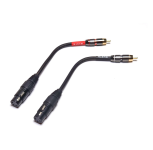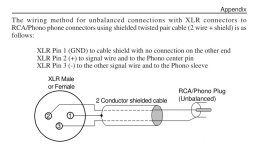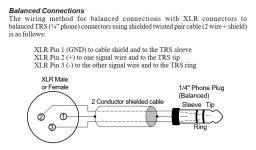Hi... Thought I'd ask first. My Lynx PCIe card outputs a stereo balanced signal of +20 dbu (pretty hot). I want to run this to a Topping headphone amp with RCA inputs. I bought these adapter cables from Amazon and I included its wiring diagram (see pics)
Is it safe to connect this or do I risk damaging something?
Thanks
Is it safe to connect this or do I risk damaging something?
Thanks
Attachments
Don't you have some potentiometer?
Where if so?
The Topping HP amp has a volume control (potentiometer) on the front of the unit
Where if so?
The Topping HP amp has a volume control (potentiometer) on the front of the unit
There are several types of balanced outputs. Some do not work well with Pin 3 grounded, others are ok with it, and still others require Pin 3 grounded. What does Lynx say about connecting their card to an unbalanced input?
It should work fine if you just don't connect Pin 3.
It should work fine if you just don't connect Pin 3.
There's something wrong. IF there is a common ground between the Lynx and the headphone amp, you're shorting Pin 3 to ground that way. I don't know your setup, but that's a possibility, more likely than not. Perhaps Lynx is ok with that short.
Not enough information here. You'll just have to take your chances. Just because it "worked perfectly" doesn't mean it's ok. I would have suggested Pin 2 > RCA center, Pin 1 > RCA outer, leave Pin 3 floating. That's more universally ok.
Not enough information here. You'll just have to take your chances. Just because it "worked perfectly" doesn't mean it's ok. I would have suggested Pin 2 > RCA center, Pin 1 > RCA outer, leave Pin 3 floating. That's more universally ok.
Well, this is direct from the company. Remember I'm dealing with XLR fully balanced breakout cables (from a Lynx E22 PCIe computer card). It could be their own topology.. not sure?
Here's the balanced connection diagram. I'm not sure if it's universal?
Here's the balanced connection diagram. I'm not sure if it's universal?
Attachments
The issue is there are several types of balanced outputs, and when interfacing correctly to an unbalanced input it is important to know which output style it is.
There are at least 3 most common balanced output types:
1. Transformer
2. Active differential
3. Cross-coupled active differential
Each connects to an unbalanced input differently.
1. Transformer output - Audio on Pin 2, but requires Pin 1 and 3 to be connected together.
2. Active differential - Audio on Pin 2, requires Pin 3 to float (not connected to anything)
3. Cross-coupled active differential - Audio on Pin 2, Pin 3 can float, but output on Pin 2 will increase 6dB if Pin 3 is tied to Pin 1.
So...which is it? Based on Lynx's reply, probably #3. But it could be #2 if the Lynx and headphone amp don't share the same ground.
See what I mean?
There are at least 3 most common balanced output types:
1. Transformer
2. Active differential
3. Cross-coupled active differential
Each connects to an unbalanced input differently.
1. Transformer output - Audio on Pin 2, but requires Pin 1 and 3 to be connected together.
2. Active differential - Audio on Pin 2, requires Pin 3 to float (not connected to anything)
3. Cross-coupled active differential - Audio on Pin 2, Pin 3 can float, but output on Pin 2 will increase 6dB if Pin 3 is tied to Pin 1.
So...which is it? Based on Lynx's reply, probably #3. But it could be #2 if the Lynx and headphone amp don't share the same ground.
See what I mean?
I'm sorry not really. My knowledge is pretty much contained to simple electronic wiring. I did decide however to get a fully balanced headphone amp instead. Not because the connection didn't work, but because I'll have the option of connecting two sets of headphones simultaneously... one for mixing and the other for tracking. I'll be using the second diagram I posted.
If you're interested in getting more information, you can send an email to Lynx: info@lynxproaudio.com
Thanks
If you're interested in getting more information, you can send an email to Lynx: info@lynxproaudio.com
Thanks
If you use #2 above, it will work, and #3 might work. If you're happy with what you have, don't change.
A fully balaned headphone amp? And you're rewiring your headphones too? Beause if you don't, it won't be "fully balanced". Really, no need at all. You can do everything you need without spending any more money, just pay attention to how things work.
Also please understand that the one and only point of a balanced interconnect is noise immunity. It's a nice sounding term, "balanced", and sounds much better than "unbalanced", but in reality, you can get slightly better performance with an unbalanced interface so long as you don't have a noise problem. On the headphone side, balanced wiring of headphones (if even possible), unless the headphone cord is of an extremely small wire size, are of no advantage.
I'm offering information, I'm not going to be using a Lynx product, so not really interested in specifics, and they probably woudn't share them anyway.
A fully balaned headphone amp? And you're rewiring your headphones too? Beause if you don't, it won't be "fully balanced". Really, no need at all. You can do everything you need without spending any more money, just pay attention to how things work.
Also please understand that the one and only point of a balanced interconnect is noise immunity. It's a nice sounding term, "balanced", and sounds much better than "unbalanced", but in reality, you can get slightly better performance with an unbalanced interface so long as you don't have a noise problem. On the headphone side, balanced wiring of headphones (if even possible), unless the headphone cord is of an extremely small wire size, are of no advantage.
I'm offering information, I'm not going to be using a Lynx product, so not really interested in specifics, and they probably woudn't share them anyway.
- Home
- Design & Build
- Electronic Design
- Is it SAFE to run an analog balanced +20 dBu signal to an RCA unbalanced headphone amp?



